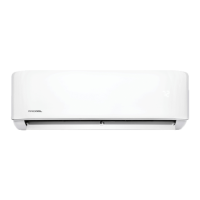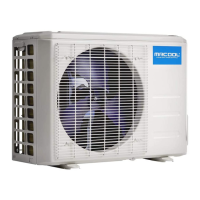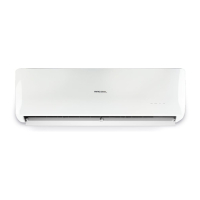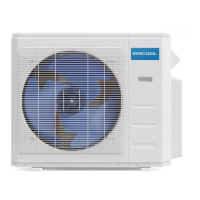Page 26
6.
7. Turn the handle of the flaring toool clockwise
until the pipe is fully flared.
Place flaring tool onto the form.
8. Remove the flaring tool and flare form, then
inspect the end of the pipe for cracks and
even flaring.
Step 4: Connect pipes
When connecting refrigerant pipes, be careful
not to use excessive torque or to deform the
piping in any way. You should first connect the
low-pressure pipe, then the high-pressure pipe.
MINIMUM BEND RADIUS
When bending connective refrigerant piping,
the minimum bending radius is 10cm. See Fig
5.6.
≥4in (10cm)Radius
TORQUE REQUIREMENTS
Outer Diameter of Pipe (in/mm) Tightening Torque ( • ) Add. Tightening Torque ( • )
Ø 0.25” (Ø 6.35) 1,500 (11lb•ft) 1,600 (11.8lb•ft)
Ø 0.375” (Ø 9.52) 2,500 (18.4lb•ft) 2,600 (19.18lb•ft)
Ø 0.5” (Ø 12.7) 3,500 (25.8lb•ft) 3,600 (26.55lb•ft)
Ø 0.63” (Ø 16) 4,500 (33.19lb•ft) 4,700 (34.67lb•ft)
DO NOT USE EXCESSIVE TORQUE
Excessive force can break the nut or damage the refrigerant piping. You must not exceed torque
requirements shown in the table above.
Instructions for Connecting Piping
to Indoor Unit
1. Align the center of the two pipes that you will
connect. See Fig. 5.7.
Indoor unit tubing Flare nut Pipe
Tighten the flare nut as tightly as possible by
hand.
Using an adjustable wrench, grip the nut on
the unit tubing.
While firmly gripping the nut on the unit
tubing, use a torque wrench to tighten the
flare nut according to the torque values in the
Torque Requirements table below. Loosen
the flaring nut slightly, then tighten again.
Fig. 5.6
Fig. 5.7
Fig. 5.8
Refrigerant Piping Connection

